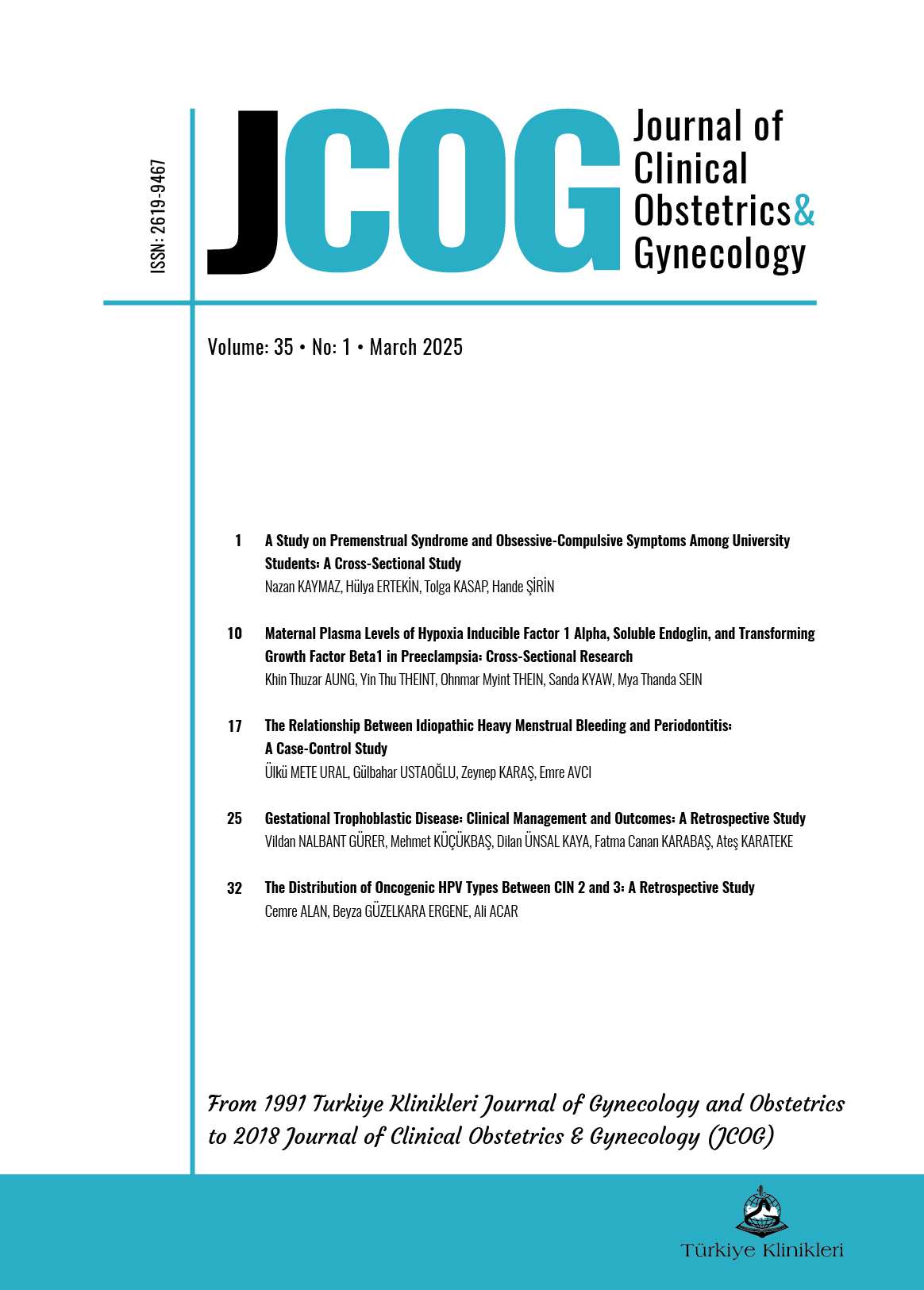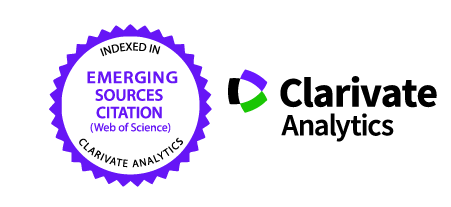Open Access
Peer Reviewed
ORIGINAL RESEARCH
710 Viewed610 Downloaded
The Relationship Between Idiopathic Heavy Menstrual Bleeding and Periodontitis: A Case-Control Study
Received: 29 Jul 2024 | Received in revised form: 25 Jan 2025
Accepted: 10 Feb 2025 | Available online: 21 Feb 2025
JCOG. 2025;35(1):17-24
DOI: 10.5336/jcog.2024-104999
Article Language: EN
Article Language: EN
Copyright Ⓒ 2025 by Türkiye Klinikleri. This is an open access article under the CC BY-NC-ND license (http://creativecommons.org/licenses/by-nc-nd/4.0/)
ABSTRACT
Objective: The cause of idiopathic heavy menstrual bleeding has not been identified, but increased systemic inflammation may be a factor. Periodontitis has an impact on general health and may cause systemic low-grade inflammation. The aim of the study was to investigate the relationship between idiopathic heavy menstrual bleeding and periodontitis. Material and Methods: A total of 60 women were included in the study. Thirty women with idiopathic heavy menstrual bleeding constituted the study group, and 30 healthy age-matched participants with normal menstrual bleeding constituted the control group. Evaluation of menstruation was performed using a pictorial-based assessment chart (PBAC) score. Periodontal status was evaluated with the gingival index, plaque index, bleeding on probing, probing depth, clinical attachment loss, total teeth number, and decay teeth number. Saliva samples were obtained to analyze the total antioxidant status, total oxidant status, arylesterase activity, and oxidative stress index levels. Results: There were no statistically significant differences in age and BMI between the study and the control groups. All the periodontal clinical parameters were found to be statistically significantly deteriorated in the idiopathic heavy menstrual bleeding group. Total antioxidant status, total oxidant status, and oxidative stress index were significantly high, and arylesterase activity was low in the study group. Conclusion: Periodontitis causes systemic inflammation and can be associated with increased endometrial inflammatory effects. Local endometrial inflammation may interfere with normal endometrial healing and reduce the ability of endometrial cells to proliferate. Inadequate restoration of normal cytoarchitecture of endometrial tissue may contribute to prolonged menstrual bleeding.
Objective: The cause of idiopathic heavy menstrual bleeding has not been identified, but increased systemic inflammation may be a factor. Periodontitis has an impact on general health and may cause systemic low-grade inflammation. The aim of the study was to investigate the relationship between idiopathic heavy menstrual bleeding and periodontitis. Material and Methods: A total of 60 women were included in the study. Thirty women with idiopathic heavy menstrual bleeding constituted the study group, and 30 healthy age-matched participants with normal menstrual bleeding constituted the control group. Evaluation of menstruation was performed using a pictorial-based assessment chart (PBAC) score. Periodontal status was evaluated with the gingival index, plaque index, bleeding on probing, probing depth, clinical attachment loss, total teeth number, and decay teeth number. Saliva samples were obtained to analyze the total antioxidant status, total oxidant status, arylesterase activity, and oxidative stress index levels. Results: There were no statistically significant differences in age and BMI between the study and the control groups. All the periodontal clinical parameters were found to be statistically significantly deteriorated in the idiopathic heavy menstrual bleeding group. Total antioxidant status, total oxidant status, and oxidative stress index were significantly high, and arylesterase activity was low in the study group. Conclusion: Periodontitis causes systemic inflammation and can be associated with increased endometrial inflammatory effects. Local endometrial inflammation may interfere with normal endometrial healing and reduce the ability of endometrial cells to proliferate. Inadequate restoration of normal cytoarchitecture of endometrial tissue may contribute to prolonged menstrual bleeding.
KEYWORDS: Idiopathic heavy menstrual bleeding; periodontitis; oxidative stress; saliva; inflammation
REFERENCES:
- Matteson KA, Boardman LA, Munro MG, Clark MA. Abnormal uterine bleeding: a review of patient-based outcome measures. Fertil Steril. 2009;92(1):205-16. [Crossref] [PubMed] [PMC]
- Munro MG, Critchley HOD, Fraser IS; FIGO Menstrual Disorders Committee. The two FIGO systems for normal and abnormal uterine bleeding symptoms and classification of causes of abnormal uterine bleeding in the reproductive years: 2018 revisions. Int J Gynaecol Obstet. 2018;143(3):393-408. Erratum in: Int J Gynaecol Obstet. 2019;144(2):237. [Crossref] [PubMed]
- Abu Hashim H. Medical treatment of idiopathic heavy menstrual bleeding. What is new? An evidence based approach. Arch Gynecol Obstet. 2013;287(2):251-60. [Crossref] [PubMed]
- Elsheikh E, Andersson E, Sylvén C, Ericzon BG, Palmblad J, Mints M. Plasma levels of stromal cell-derived factor-1 (CXCL12) and circulating endothelial progenitor cells in women with idiopathic heavy menstrual bleeding. Hum Reprod. 2014;29(1):49-56. [Crossref] [PubMed]
- Papapanou PN, Sanz M, Buduneli N, Dietrich T, Feres M, Fine DH, et al. Periodontitis: Consensus report of workgroup 2 of the 2017 World Workshop on the Classification of Periodontal and Peri-Implant Diseases and Conditions. J Periodontol. 2018;89 Suppl 1:S173-S182. [PubMed]
- Demmer RT, Desvarieux M. Periodontal infections and cardiovascular disease: the heart of the matter. J Am Dent Assoc. 2006;137 Suppl:14S-20S [Crossref] [PubMed]
- Corbella S, Taschieri S, Del Fabbro M, Francetti L, Weinstein R, Ferrazzi E. Adverse pregnancy outcomes and periodontitis: a systematic review and meta-analysis exploring potential association. Quintessence Int. 2016;47(3):193-204. [PubMed]
- Bansal M, Khatri M, Taneja V. Potential role of periodontal infection in respiratory diseases - a review. J Med Life. 2013;6(3):244-8. [PubMed] [PMC]
- Critchley HOD, Maybin JA, Armstrong GM, Williams ARW. Physiology of the endometrium and regulation of menstruation. Physiol Rev. 2020;100(3):1149-79. [Crossref] [PubMed]
- Malik S, Day K, Perrault I, Charnock-Jones DS, Smith SK. Reduced levels of VEGF-A and MMP-2 and MMP-9 activity and increased TNF-alpha in menstrual endometrium and effluent in women with menorrhagia. Hum Reprod. 2006;21(8):2158-66. [Crossref] [PubMed]
- Slade GD, Ghezzi EM, Heiss G, Beck JD, Riche E, Offenbacher S. Relationship between periodontal disease and C-reactive protein among adults in the atherosclerosis risk in communities study. Arch Intern Med. 2003;163(10):1172-9. [Crossref] [PubMed]
- Arana C, Moreno-Fernández AM, Gómez-Moreno G, Morales-Portillo C, Serrano-Olmedo I, de la Cuesta Mayor MC, et al. Increased salivary oxidative stress parameters in patients with type 2 diabetes: Relation with periodontal disease. Endocrinol Diabetes Nutr. 2017;64(5):258-64. English, Spanish. [Crossref] [PubMed]
- Corlan Puşcu D, Ciuluvică RC, Anghel A, Mălăescu GD, Ciursaş AN, Popa GV, et al. Periodontal disease in diabetic patients - clinical and histopathological aspects. Rom J Morphol Embryol. 2016;57(4):1323-9. [PubMed]
- Zakherah MS, Sayed GH, El-Nashar SA, Shaaban MM. Pictorial blood loss assessment chart in the evaluation of heavy menstrual bleeding: diagnostic accuracy compared to alkaline hematin. Gynecol Obstet Invest. 2011;71(4):281-4. [Crossref] [PubMed]
- Herman MC, Penninx J, Geomini PM, Mol BW, Bongers MY. Choice of primary outcomes evaluating treatment for heavy menstrual bleeding. BJOG. 2016;123(10):1593-8. [Crossref] [PubMed]
- Löe H. The Gingival Index, the Plaque Index and the Retention Index Systems. J Periodontol. 1967;38(6):Suppl:610-6. [Crossref] [PubMed]
- Silness J, Loe H. Periodontal disease in pregnancy. II. Correlation between oral hygiene and periodontal condtion. Acta Odontol Scand. 1964;22:121-35. [Crossref] [PubMed]
- Erel O. A new automated colorimetric method for measuring total oxidant status. Clin Biochem. 2005;38(12):1103-11. [Crossref] [PubMed]
- Yumru M, Savas HA, Kalenderoglu A, Bulut M, Celik H, Erel O. Oxidative imbalance in bipolar disorder subtypes: a comparative study. Prog Neuropsychopharmacol Biol Psychiatry. 2009;33(6):1070-4. [Crossref] [PubMed]
- Sczepanik FSC, Grossi ML, Casati M, Goldberg M, Glogauer M, Fine N, et al. Periodontitis is an inflammatory disease of oxidative stress: We should treat it that way. Periodontol 2000. 2020;84(1):45-68. [Crossref] [PubMed]
- Maybin JA, Boswell L, Young VJ, Duncan WC, Critchley HOD. Reduced transforming growth factor-β activity in the endometrium of women with heavy menstrual bleeding. J Clin Endocrinol Metab. 2017;102(4):1299-308. [Crossref] [PubMed] [PMC]
- Critchley HO, Kelly RW, Brenner RM, Baird DT. The endocrinology of menstruation-a role for the immune system. Clin Endocrinol (Oxf). 2001;55(6):701-10. [Crossref] [PubMed]
- Heavy menstrual bleeding: assessment and management. London: National Institute for Health and Care Excellence (NICE); 2021. [PubMed]
- Smith OP, Jabbour HN, Critchley HO. Cyclooxygenase enzyme expression and E series prostaglandin receptor signalling are enhanced in heavy menstruation. Hum Reprod. 2007;22(5):1450-6. [Crossref] [PubMed] [PMC]
- Dias IH, Matthews JB, Chapple IL, Wright HJ, Dunston CR, Griffiths HR. Activation of the neutrophil respiratory burst by plasma from periodontitis patients is mediated by pro-inflammatory cytokines. J Clin Periodontol. 2011;38(1):1-7. [Crossref] [PubMed]
- Buczko P, Zalewska A, Szarmach I. Saliva and oxidative stress in oral cavity and in some systemic disorders. J Physiol Pharmacol. 2015;66(1):3-9. [PubMed]
- Nagler RM, Klein I, Zarzhevsky N, Drigues N, Reznick AZ. Characterization of the differentiated antioxidant profile of human saliva. Free Radic Biol Med. 2002;32(3):268-77. [Crossref] [PubMed]
- Reavey JJ, Walker C, Nicol M, Murray AA, Critchley HOD, Kershaw LE, et al. Markers of human endometrial hypoxia can be detected in vivo and ex vivo during physiological menstruation. Hum Reprod. 2021;36(4):941-50. [Crossref] [PubMed] [PMC]
- Cross A, Barnes T, Bucknall RC, Edwards SW, Moots RJ. Neutrophil apoptosis in rheumatoid arthritis is regulated by local oxygen tensions within joints. J Leukoc Biol. 2006;80(3):521-8. [Crossref] [PubMed]
- Serhan CN, Savill J. Resolution of inflammation: the beginning programs the end. Nat Immunol. 2005;6(12):1191-7. [Crossref] [PubMed]
- Kaitu'u-Lino TJ, Morison NB, Salamonsen LA. Neutrophil depletion retards endometrial repair in a mouse model. Cell Tissue Res. 2007;328(1):197-206. [Crossref] [PubMed]
- Reavey JJ, Walker C, Murray AA, Brito-Mutunayagam S, Sweeney S, Nicol M, et al. Obesity is associated with heavy menstruation that may be due to delayed endometrial repair. J Endocrinol. 2021;249(2):71-82. [Crossref] [PubMed] [PMC]
- Mao C, Liu X, Guo SW. Decreased glycolysis at menstruation is associated with increased menstrual blood loss. Reprod Sci. 2023;30(3):928-51. [Crossref] [PubMed]
- Malanchuk LM, Riabokon MO, Malanchuk AS, Riabokon SS, Malanchuk SL, Martyniuk VM, et al. Relationship between pathological menstrual symptoms and the development of extragenital forms of local inflammation. Wiad Lek. 2021;74(1):64-7. [Crossref] [PubMed]
- Kobayashi H. Endometrial inflammation and impaired spontaneous decidualization: insights into the pathogenesis of adenomyosis. Int J Environ Res Public Health. 2023;20(4):3762. [Crossref] [PubMed] [PMC]
MENU
POPULAR ARTICLES
MOST DOWNLOADED ARTICLES





This journal is licensed under a Creative Commons Attribution-NonCommercial-NoDerivatives 4.0 International License.










